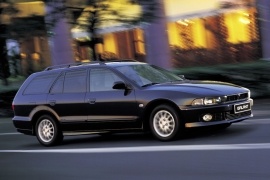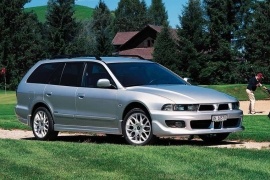MITSUBISHI Galant Station Wagon Models/Series Timeline, Specifications & Photos
First production year: 1997
Engines: Gasoline, Diesel
Body style: Wagon (station wagon, estate, combi, touring)
Mitsubishi introduced a station wagon version for the Galant's eighth-generation in 1997 and dropped the hatchback from its offer.
Between the fourth and eighth generations, the Japanese mid-size vehicle was offered only as a hatchback or sedan. But the increased demand for family vehicles forced Mitsubishi to offer it as a station wagon as well. It was also the last mid-size segment station wagon Galant built by Mitsubishi.
At the front, the shark-nose design imagined by the Japanese designer Akinori Nakanishi sported a trapezoidal grille surrounded by a chromed trim. Its narrow headlights with corner-mounted turn signals and the tall wrapped-around front bumper created an aggressive appearance for the station wagon. Mitsubishi added raked-forward windows behind the C-pillars and a tilted tailgate.
Inside, the Galant offered seating for five with enough legroom for the rear outboard passengers and limited for the one seated in the middle due to the transmission tunnel. Mitsubishi used the same floor for the entire range, regardless of the front- or all-wheel-drive systems. The folding rear bench increased the trunk size when collapsed from 420 liters (18.8 cu-ft) to 1,400 liters (49.4 cu-ft).
Under the hood, Mitsubishi installed a choice of gasoline engines ranged between 136 hp and 163 hp. For selected markets, it offered a turbo-diesel version which provided 90 hp.
Mitsubishi dared more than its competitors and introduced a station wagon bodywork for the top-performance version Galant VR4 in 1997.
Most station wagons from the late '90s were just spacious cars for regular families. But there were just a few carmakers that cared about performance versions. However, Mitsubishi did consider that it might sell the Galant Wagon with a more powerful engine and all the other gizmos offered by the Galant VR4 sedan.
Unlike the regular Galant Wagon version, the VR4 featured a more aggressive front bumper. A lowered apron sported a center air intake split in three, flanked by the foglights clusters. The 16" light-alloy wheels offered as standard were similar to those installed on the Galant VR4 sedan. As an option, the carmaker provided the car with a set of BBS alloys. Last but not least, to emphasize the car's performance, Mitsubishi installed a roof spoiler at the top of the tailgate.
Inside, the carmaker installed high-bolstered front bucket seats to hold their occupants well into position during high-speed cornering. At the back, it was just the regular bench for three installed on the rest of the range. Even though it offered room for three, it sported just two headrests. The rear bench seatback could have been folded to increase the trunk space from 420 liters (14.8 cu-ft) to 1,400 liters (49.4 cu-ft).
Under the hood, Mitsubishi installed a 2.5-liter, twin-turbo V-6 engine. It was paired with a standard five-speed manual or a five-speed automatic transmission from Porsche (Tiptronic), which offered the possibility to change gears sequentially by pulling or pushing the gear lever. The most important part of the car was the drivetrain, which featured an all-wheel-drive system with an active rear differential (Active Yaw Control) available as an option. Moreover, the carmaker installed an all-wheel-steering system.
MITSUBISHI Galant Station Wagon VR-4 2.5L V6 Biturbo 5MT AWD (280 HP)

